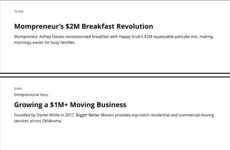
Non-Profit Building Potential Through Community
Tiana Reid — April 18, 2012 — Social Good
References: phinklife.org & twitter
Social entrepreneur Duncan So is the Founder and Chief Catalyst at Phinklife Inc., a social enterprise that takes its philosophy -- or, Phinkology -- seriously. In essence, it's all about leveraging a platform in order to create meaningful lives packed to the brim with happiness, good and a diehard fiery energy to top that all off.
Here, Duncan So explains, among other things, the team's decision to opt for a non-profit model rather than a for-profit model, which is a decision many social enterprise start-ups have to make, especially in an environment like Canada that does not offer a hybrid model such as, for instance, the United States' B Corp or the United Kingdom's community interest company.
Four Questions with Duncan So
1. How did the idea for the business model come about?
Our business model is quite an organic process. First and foremost, Phinklife is a social movement and while looking at the different angles to the overall problem, we develop revenue generating business models for each and all of our programs and solutions that target different groups. Our goal is that we minimize and have no cost centers in our operations. It’s our belief of harnessing organizational human potential –- everyone generates value.
2. How did you decide to join this sector?
This was actually more principle driven. As a team at Phinklife, we knew we were going to be in the social purpose space –- either a for-profit pushing a social cause, or a non-profit that generates revenue. We chose the social enterprise (non-profit) model because it resonated with our values. As a movement, our brand and reputation to the people we help come first-and-foremost, and by fostering this change we believe that the value we create would reflect well to support our initiatives and programs. The intent for monetization really turns into a reflection and a testimonial from the people we help, as they are our true shareholders.
3. How do you get your inspiration?
It came from a F.M.L. moment (frustrated with my life!). Along with many Generation Y, all my friends and people around me became frustrated with how much of a grind life was –- stemming from our chosen job/career, it manifested and spiraled into our relationships, health and overall well-being. Eventually, we found everyone hit that moment of realization. There was no system or solution that was available to the masses –- a reality check that led our group to understand how important and powerful it would be if we could all live passionately and manifest that into the fabric of our life.
As we looked at designing an end-to-end solution, we realized it had the potential of massive social impact. It would change the way we live, think, learn and socially connect with others, and we could integrate and leverage into existing systems: business, financial, education, political, government, health care as other channels to focus around passion, happiness, fulfillment and the well-being of human kind.
The inspiration then really hit, and from there was born our social mission: To create a world where everyone can live to their fullest potential.
4. How do you reset yourself to be creative? Do you have any rituals?
Habits, really. We are all creatures of habits. We used our own processes to find and harness our passions. Opening up to be creative is a natural by-product of passion and tapping into human potential. Hurrah! Passion for the win.
Here, Duncan So explains, among other things, the team's decision to opt for a non-profit model rather than a for-profit model, which is a decision many social enterprise start-ups have to make, especially in an environment like Canada that does not offer a hybrid model such as, for instance, the United States' B Corp or the United Kingdom's community interest company.
Four Questions with Duncan So
1. How did the idea for the business model come about?
Our business model is quite an organic process. First and foremost, Phinklife is a social movement and while looking at the different angles to the overall problem, we develop revenue generating business models for each and all of our programs and solutions that target different groups. Our goal is that we minimize and have no cost centers in our operations. It’s our belief of harnessing organizational human potential –- everyone generates value.
2. How did you decide to join this sector?
This was actually more principle driven. As a team at Phinklife, we knew we were going to be in the social purpose space –- either a for-profit pushing a social cause, or a non-profit that generates revenue. We chose the social enterprise (non-profit) model because it resonated with our values. As a movement, our brand and reputation to the people we help come first-and-foremost, and by fostering this change we believe that the value we create would reflect well to support our initiatives and programs. The intent for monetization really turns into a reflection and a testimonial from the people we help, as they are our true shareholders.
3. How do you get your inspiration?
It came from a F.M.L. moment (frustrated with my life!). Along with many Generation Y, all my friends and people around me became frustrated with how much of a grind life was –- stemming from our chosen job/career, it manifested and spiraled into our relationships, health and overall well-being. Eventually, we found everyone hit that moment of realization. There was no system or solution that was available to the masses –- a reality check that led our group to understand how important and powerful it would be if we could all live passionately and manifest that into the fabric of our life.
As we looked at designing an end-to-end solution, we realized it had the potential of massive social impact. It would change the way we live, think, learn and socially connect with others, and we could integrate and leverage into existing systems: business, financial, education, political, government, health care as other channels to focus around passion, happiness, fulfillment and the well-being of human kind.
The inspiration then really hit, and from there was born our social mission: To create a world where everyone can live to their fullest potential.
4. How do you reset yourself to be creative? Do you have any rituals?
Habits, really. We are all creatures of habits. We used our own processes to find and harness our passions. Opening up to be creative is a natural by-product of passion and tapping into human potential. Hurrah! Passion for the win.
Trend Themes
1. Social Entrepreneurship - Phinklife was created with the goal of maximizing the positive impact of social innovation.
2. Organic Business Model Development - Phinklife developed its business models based on the different solutions it created to target different groups and minimize and eliminate cost centers.
3. Human Potential Optimization - Phinklife believes that everyone generates value and that a world where everyone can live to their fullest potential can be created.
Industry Implications
1. Non-profit - Phinklife opted for a non-profit model because it aligns with their values and allows them to prioritize the people they help first and foremost.
2. Social Purpose - Phinklife chose to enter the social purpose space and generate revenue as a non-profit with the intention of creating massive social impact.
3. Social Movement - Phinklife was born out of frustration with the grind of life and the potential to change the way we live, think, learn and socially connect with others.
3.7
Score
Popularity
Activity
Freshness























